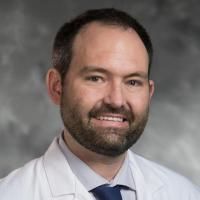Mutations in IDH1, IDH2, and in the TERT promoter define clinically distinct subgroups of adult malignant gliomas.
Date
2014-03-30
Journal Title
Journal ISSN
Volume Title
Repository Usage Stats
views
downloads
Citation Stats
Attention Stats
Abstract
Frequent mutations in isocitrate dehydrogenase 1 and 2 (IDH1 and IDH2) and the promoter of telomerase reverse transcriptase (TERT) represent two significant discoveries in glioma genomics. Understanding the degree to which these two mutations co-occur or occur exclusively of one another in glioma subtypes presents a unique opportunity to guide glioma classification and prognosis. We analyzed the relationship between overall survival (OS) and the presence of IDH1/2 and TERT promoter mutations in a panel of 473 adult gliomas. We hypothesized and show that genetic signatures capable of distinguishing among several types of gliomas could be established providing clinically relevant information that can serve as an adjunct to histopathological diagnosis. We found that mutations in the TERT promoter occurred in 74.2% of glioblastomas (GBM), but occurred in a minority of Grade II-III astrocytomas (18.2%). In contrast, IDH1/2 mutations were observed in 78.4% of Grade II-III astrocytomas, but were uncommon in primary GBM. In oligodendrogliomas, TERT promoter and IDH1/2 mutations co-occurred in 79% of cases. Patients whose Grade III-IV gliomas exhibit TERT promoter mutations alone predominately have primary GBMs associated with poor median OS (11.5 months). Patients whose Grade III-IV gliomas exhibit IDH1/2 mutations alone predominately have astrocytic morphologies and exhibit a median OS of 57 months while patients whose tumors exhibit both TERT promoter and IDH1/2 mutations predominately exhibit oligodendroglial morphologies and exhibit median OS of 125 months. Analyzing gliomas based on their genetic signatures allows for the stratification of these patients into distinct cohorts, with unique prognosis and survival.
Type
Department
Description
Provenance
Citation
Permalink
Published Version (Please cite this version)
Publication Info
Killela, Patrick J, Christopher J Pirozzi, Patrick Healy, Zachary J Reitman, Eric Lipp, B Ahmed Rasheed, Rui Yang, Bill H Diplas, et al. (2014). Mutations in IDH1, IDH2, and in the TERT promoter define clinically distinct subgroups of adult malignant gliomas. Oncotarget, 5(6). pp. 1515–1525. 10.18632/oncotarget.1765 Retrieved from https://hdl.handle.net/10161/16105.
This is constructed from limited available data and may be imprecise. To cite this article, please review & use the official citation provided by the journal.
Collections
Scholars@Duke

Christopher Pirozzi
Dr. Pirozzi's work thus far has been dedicated to studying brain tumors, particularly gliomas. During his research career, he has focused on identifying the common mutations present in gliomas and how these different mutations correlate with diagnoses and prognoses. To this end, Christopher was involved in several publications that identified and stratified brain tumor patients based on their mutation spectrum. For example, mutations in ATRX, CIC, FUBP1, and IDH1 can be used to distinguish patients with astrocytomas or oligodendrogliomas on a genetic level which can complement the difficult work of neuropathologists and better direct patient therapeutics. Christopher utilized these mutations as a foundation for animal modeling, leading to genetically faithful and biologically relevant systems that are applied to both basic research to understand the pathogenic nature of these mutations, as well as pre-clinical and translational research to understand how best to treat these tumors. Christopher’s work in animal modeling and understanding mutant IDH1-mediated gliomagenesis was recognized in several forms including first place winner of the Duke University School of Medicine’s Clinical Research Day poster session, being an invited speaker at the annual Department of Pathology’s Retreat, and as the recipient of the Robert and Barbara Bell Basic Science Cancer Research Award recognized at the Fifth Annual DCI Scientific Retreat in 2017.
Dr. Pirozzi is currently working on utilizing those mutations identified in the human genetic screens for immunotherapeutic purposes. He has generated a series of orthotopic intracranial injection-based immune-competent animal models for which he is actively investigating the impact the mutations have on the tumor-immune microenvironment and whether the tumor-immune microenvironment can be manipulated to promote an anti-tumor response. Specifically, his most recently funded Department of Defense Idea Award with Special Focus entails understanding the impact mutant IDH1 is having on the Th17 T cell lineage and whether this can be exploited for therapeutic purposes.
Christopher contributed to the successful funding of several grants including a Duke Cancer Institute Cancer Research Pilot Grant as well as an R33, focusing on the identification and cloning of mutation-specific T cell receptors that could be used for adoptive transfer. Understanding the tumor-immune microenvironment and whether it can be manipulated to improve therapeutics or promote an anti-tumor immune response, and the identification of tumor-specific therapies that will avoid collateral damage to the sensitive brain are active lines of investigation.

Zachary James Reitman
Dr. Reitman’s clinical interests include radiotherapy for primary and metastatic tumors of the brain and spine. He is also interested in basic and translational research studies to develop new treatment approaches for pediatric and adult brain tumors. He uses genomic analysis, radiation biology studies, and genetically engineered animal models of cancer to carry out this research
Unless otherwise indicated, scholarly articles published by Duke faculty members are made available here with a CC-BY-NC (Creative Commons Attribution Non-Commercial) license, as enabled by the Duke Open Access Policy. If you wish to use the materials in ways not already permitted under CC-BY-NC, please consult the copyright owner. Other materials are made available here through the author’s grant of a non-exclusive license to make their work openly accessible.
